ASEAN (150 found)
Myanmar : Floods Emergency Situation Report (No.4)
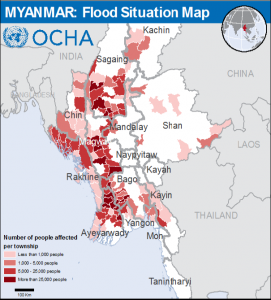 As of 13 August, the NDMC reports that over 1,350,000 people have been severely affected by floods and landslides in July and August. This includes a cumulative number of over 297,000 households that have been or remain temporarily displaced during this period […]
As of 13 August, the NDMC reports that over 1,350,000 people have been severely affected by floods and landslides in July and August. This includes a cumulative number of over 297,000 households that have been or remain temporarily displaced during this period […]
Myanmar: Floods Emergency Situation Report ( No.3)
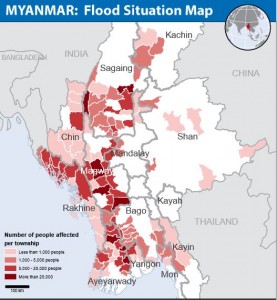 As of 10 August, the National Natural Disaster Management Committee (NDMC) reports that over 1.1 million people have been severely affected by floods and landslides since mid-July. This includes a cumulative number of over 240,000 households that have been or remain temporarily displaced during this period […]
As of 10 August, the National Natural Disaster Management Committee (NDMC) reports that over 1.1 million people have been severely affected by floods and landslides since mid-July. This includes a cumulative number of over 240,000 households that have been or remain temporarily displaced during this period […]
Myanmar: Situation Report No.1 – National Natural Disaster Management Committee
Torrential rain starting from 16 July 2015 in the Northern part of Myanmar and Cyclone Komen that landfall Bengladesh has triggered severe and widespread floods and landslides across twelve states and regions in Myanmar […]
• • •Myanmar: Floods Emergency Situation Report ( No.2)
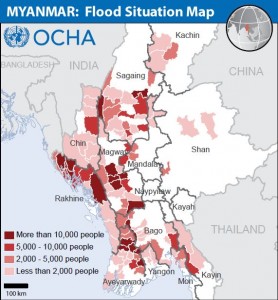 As of 7 August, the Government of Myanmar’s Relief and Resettlement Department (RRD) reports that close to
As of 7 August, the Government of Myanmar’s Relief and Resettlement Department (RRD) reports that close to
590,000 people have been severely affected by monsoonal floods across 12 of Myanmar’s 14 states and regions
since mid-July. This includes a cumulative number of 122,200 households that have been or remain temporarily
displaced during this period. More than 17 million people live in townships that have been inundated by floods in
July and August, according to RRD. At least 96 people are confirmed to have died in the floods since June.
Recent Fighting between Tatmadaw and DKBA Soldiers Leads to Killing and Displacement of Villagers in Hpa-an District
On July 8th 2015, a female villager named Naw D—, from G— village, reported to KHRG that on the evening of July 6th 2015, Tatmadaw soldiers began firing small machine guns and grenade launchers at the Democratic Karen Benevolent Army (DKBA)[2]camp in Waw Poo Bridge area, Meh Th’Waw village. Villagers who live in the villages near the location where the fighting took place have fled from their villages for their own safety […]
• • •Myanmar: Stalled reforms: impunity, discrimination and ongoing human rights abuses: Amnesty International Submission to the UN Universal Periodic Review, November 2015
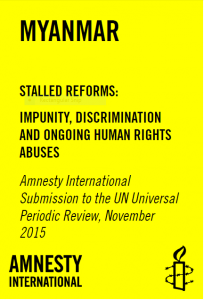 This report was originally prepared as a submission for the Universal Periodic Review (UPR) of Myanmar due to take place in November 2015 […]
This report was originally prepared as a submission for the Universal Periodic Review (UPR) of Myanmar due to take place in November 2015 […]
Land and River Grabbing: The Mekong’s Greatest Challenge
07-Land-and-River-Grabbing-2015 sm 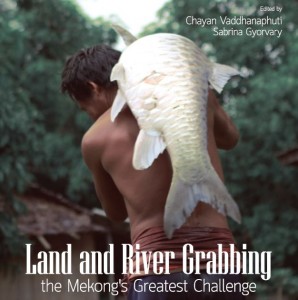 Throughout the Mekong region, large-scale development projects such as hydropower dams, mines, conventional power plants, and mono-crop plantations are displacing communities and limiting access to natural resources. Several hydropower dams have already been built on the Upper Mekong in China’s Yunnan Province, and the governments of Cambodia, Laos and Thailand are planning eleven additional large dams on the Mekong River’s mainstream. If completed, these dams would not only destroy local ecosystems, but also reduce the fl ow of silt throughout the Mekong River system, and block major fi sh migrations, placing at risk over sixty million people who depend on the Mekong for their food security and income […]
Throughout the Mekong region, large-scale development projects such as hydropower dams, mines, conventional power plants, and mono-crop plantations are displacing communities and limiting access to natural resources. Several hydropower dams have already been built on the Upper Mekong in China’s Yunnan Province, and the governments of Cambodia, Laos and Thailand are planning eleven additional large dams on the Mekong River’s mainstream. If completed, these dams would not only destroy local ecosystems, but also reduce the fl ow of silt throughout the Mekong River system, and block major fi sh migrations, placing at risk over sixty million people who depend on the Mekong for their food security and income […]
Report Briefer: How to Defend the Defenders? A Report on the Situation of Human Rights Defenders in Burma and Appropriate Protection Mechanisms
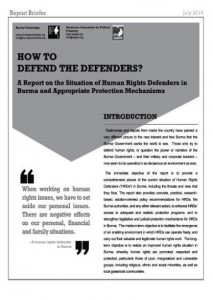 Testimonies and reports from inside the country have painted a very different picture to the new tolerant and free Burma that the Burma Government wants the world to see. Those who try to defend human rights, or question the power or narrative of the Burma Government — and their military and corporate backers —now seem to be operating in as dangerous an environment as ever […]
Testimonies and reports from inside the country have painted a very different picture to the new tolerant and free Burma that the Burma Government wants the world to see. Those who try to defend human rights, or question the power or narrative of the Burma Government — and their military and corporate backers —now seem to be operating in as dangerous an environment as ever […]
How to Defend the Defenders? A Report on the Situation of Human Rights Defenders in Burma and Appropriate Protection Mechanisms
HRD Report  Testimonies and reports from inside the country have painted a very different picture to the new tolerant and free Burma that the Burma Government wants the world to see. Those who try to defend human rights, or question the power or narrative of the Burma Government — and their military and corporate backers —now seem to be operating in as dangerous an environment as ever […]
Testimonies and reports from inside the country have painted a very different picture to the new tolerant and free Burma that the Burma Government wants the world to see. Those who try to defend human rights, or question the power or narrative of the Burma Government — and their military and corporate backers —now seem to be operating in as dangerous an environment as ever […]
FBR Report: June Update – Mali Yang Offensive Continues
On Saturday, 11 July the Burma Army and Burma Air Force launched an offensive near Mali Yang Village in northern Kachin State […]
• • •
 All posts
All posts